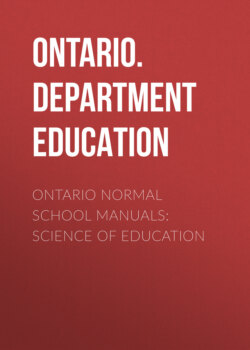Читать книгу Ontario Normal School Manuals: Science of Education - Ontario. Department of Education - Страница 20
EDUCATION AS ADJUSTMENT
ОглавлениеExample from Writing.—An examination of any ordinary educative process taken from school-room experience will show that it involves in some degree the factors mentioned above.
As a very simple example, may be taken the case of a young child learning to form capital letters with short sticks. Assuming that he has already copied letters involving straight lines, such as A, H, etc., the child, on meeting such a letter as C or D, finds himself face to face with a new problem. At first he may perhaps attempt to form the curves by bending the short thin sticks. Hereupon, either through his own failure or through some suggestion of his teacher, he comes to see a short, straight line as part of a large curve. Thereupon he forms the idea of a curve composed of a number of short, straight lines, and on this principle is able to express himself in such forms as are shown here.
In this simple process of adjustment there are clearly involved the four stages referred to above, as follows:
1. The Problem.—The forming of a curved letter by means of straight sticks.
2. A Selecting Process.—Selecting of the ideas straight and curved and the fixing of attention upon them.
3. A Relating Process.—An organization of the selected ideas into a new experience in which the curve is viewed as made up of a number of short, straight lines.
4. Expression.—Working out the physical expression of the new experience in the actual forming of capitals involving curved lines.
Example from Arithmetic.—An analysis of the process by which a child learns that there are four twos in eight, shows also the following factors:
1. The Problem.—To find out how many twos are contained in the vaguely known eight.
2. A Selecting Process.—To meet this problem the pupil is led from his present knowledge of the number two, to proceed to divide eight objects into groups of two; and, from his previous knowledge of the number four, to measure the number of these groups of two.
3. A Relating Process.—Next the three ideas two, four, and eight are translated into a new experience, constituting a mental solution of the present problem.
4. Expression.—This new experience expresses itself in various ways in the child's dealings with the number problems connected with his environment.
Example from Geometry.—Taking as another example the process by which a student may learn that the exterior angle of a triangle is equal to the two interior and opposite angles, there appear also the same stages, thus:
1. The Problem.—The conception of a difficulty or problem in the geometrical environment which calls for solution, or adjustment—the relation of the angle a to the angles b and c in Figure 1.
| Fig. 1 | Fig. 2 | Fig. 3 |
2. A Selecting Process.—With this problem as a motive there follows, as suggested by Figure 2, the selecting of a series of ideas from the previous experiences of the pupil which seem relative to, or are considered valuable for solving the problem in hand.
3. A Relating Process.—These relative ideas pass into the formation of a new experience, as illustrated in Figure 3, constituting the solution of the problem.
4. Expression.—A further applying of this experience may be made in adjusting the pupil to other problems connected with his geometric environment; as, for example, to discover the sum of the interior angles of a triangle.
